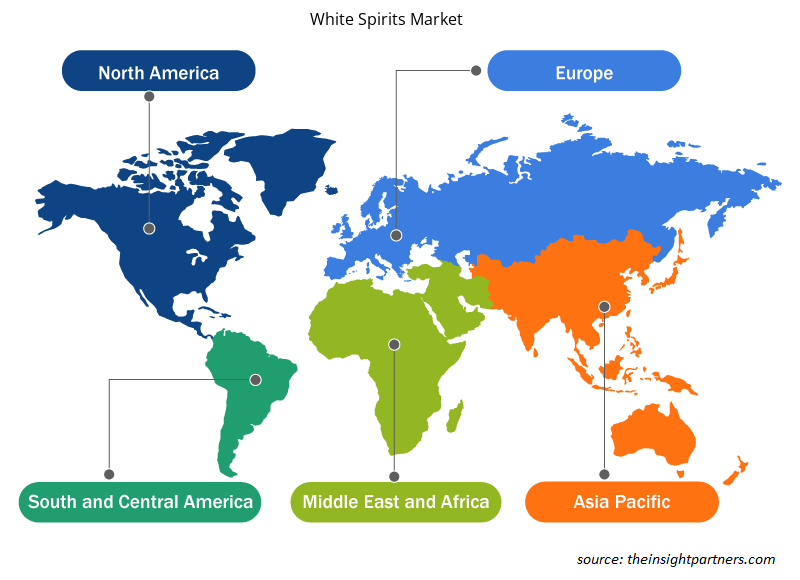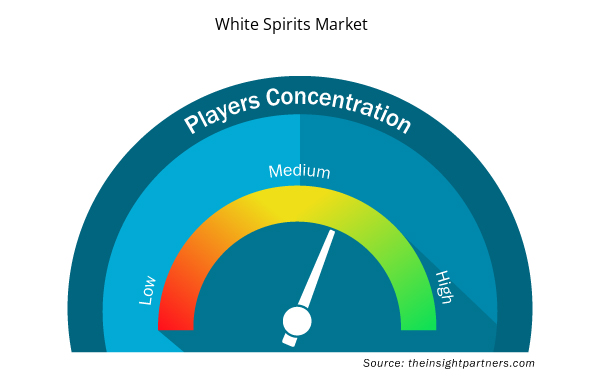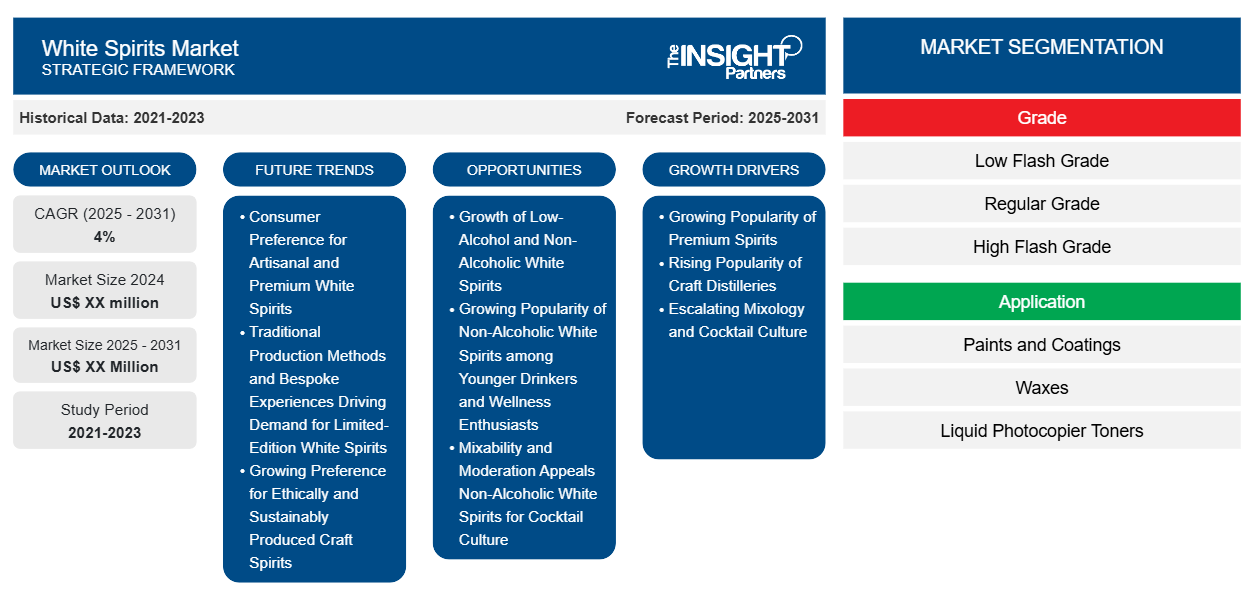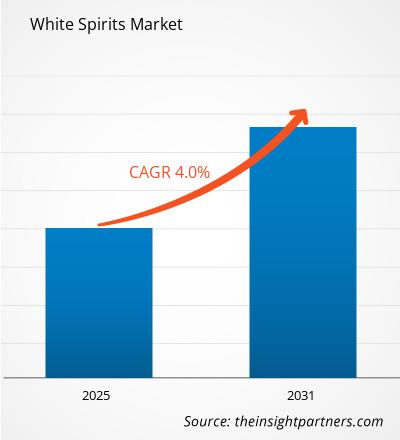Es wird erwartet, dass der Markt für weiße Spirituosen von 2023 bis 2031 eine durchschnittliche jährliche Wachstumsrate von 4 % verzeichnet und dass die Marktgröße von XX Millionen US-Dollar im Jahr 2023 auf XX Millionen US-Dollar im Jahr 2031 wächst.
Der Bericht präsentiert eine Analyse basierend auf der Qualität (niedrige Flash-Qualität, normale Qualität und hohe Flash-Qualität). Der Bericht ist nach Anwendung segmentiert (Farben und Beschichtungen, Wachse, flüssige Kopiertoner, Klebstoffe, Druckfarben und andere). Die globale Analyse ist weiter auf regionaler Ebene und in die wichtigsten Länder unterteilt. Die Marktgröße und -prognose auf globaler, regionaler und Länderebene für alle wichtigen Marktsegmente werden im Rahmen abgedeckt. Der Bericht bietet den Wert in USD für die oben genannte Analyse und die Segmente. Der Bericht bietet wichtige Statistiken zum Marktstatus der wichtigsten Marktteilnehmer und bietet Markttrends und -chancen.
Zweck des Berichts
Der Bericht „White Spirits Market“ von The Insight Partners soll die aktuelle Situation und das zukünftige Wachstum sowie die wichtigsten treibenden Faktoren, Herausforderungen und Chancen beschreiben. Dies wird verschiedenen Geschäftspartnern Einblicke geben, wie zum Beispiel:
- Technologieanbieter/-hersteller: Um die sich entwickelnde Marktdynamik zu verstehen und die potenziellen Wachstumschancen zu kennen, damit sie fundierte strategische Entscheidungen treffen können.
- Investoren: Durchführung einer umfassenden Trendanalyse hinsichtlich der Marktwachstumsrate, der finanziellen Marktprognosen und der Chancen entlang der Wertschöpfungskette.
- Regulierungsbehörden: Zur Regulierung von Richtlinien und Überwachungsaktivitäten auf dem Markt mit dem Ziel, Missbrauch zu minimieren, das Vertrauen der Anleger zu bewahren und die Integrität und Stabilität des Marktes aufrechtzuerhalten.
Marktsegmentierung für weiße Spirituosen
Grad
- Niedriger Flash-Grad
- Regelmäßige Note
- Hohe Flash-Qualität
Anwendung
- Farben und Lacke
- Wachse
- Flüssiger Kopiertoner
- Klebstoffe
- Druckfarben
- Sonstiges
Passen Sie diesen Bericht Ihren Anforderungen an
Sie erhalten kostenlos individuelle Anpassungen an jedem Bericht, einschließlich Teilen dieses Berichts oder einer Analyse auf Länderebene, eines Excel-Datenpakets sowie tolle Angebote und Rabatte für Start-ups und Universitäten.
- Holen Sie sich die wichtigsten Markttrends aus diesem Bericht.Dieses KOSTENLOSE Beispiel umfasst eine Datenanalyse von Markttrends bis hin zu Schätzungen und Prognosen.
Wachstumstreiber auf dem Markt für weiße Spirituosen
- Wachsende Beliebtheit von Premium-Spirituosen: Die steigende Beliebtheit von Premium- und Craft-Spirituosen schafft einen starken Wachstumsmotor für den Markt für weiße Spirituosen. Verbraucher suchen zunehmend nach hochwertigen, einzigartigen und handwerklich hergestellten Produkten. Dies hat zu einer steigenden Nachfrage nach hochwertigem Wodka, Gin und seit neuestem auch Tequila geführt. In dem Moment, in dem sich der Trend von Quantität zu Qualität verschiebt, hat dies die Denkweise geändert und Innovationen im Premium-Sektor gefördert.
- Steigende Beliebtheit von Craft-Destillerien: Craft-Destillerien, die kleine, einzigartige Chargen produzieren, werden von vielen wegen ihres Wertes und ihrer Einzigartigkeit geschätzt. Da Verbraucher bei ihren Trinkerlebnissen immer experimentierfreudiger werden, sind sie eher bereit, Craft-Spirituosen und deren Angebote zu erkunden, was die Markttrends für neue Sorten beeinflusst. Dies trägt dazu bei, die Ausweitung der Kategorie der weißen Spirituosen voranzutreiben.
- Zunehmende Mixologie und Cocktailkultur: Darüber hinaus heizt das Interesse an Mixologen und Cocktailkultur das Wachstum zusätzlich an. So wenden sich beispielsweise sowohl Barkeeper als auch Liebhaber von Cocktails zu Hause von milden Spirituosen ab und verwenden für die Cocktailkreation hochwertigere weiße Spirituosen. Da Cocktail-orientierte Bars und Restaurants ihre Premium-Spirituosen-Routine aufwerten, werden die Verbraucher bei der Zubereitung zu Hause nachziehen wollen, was die Nachfrage nach hochwertigen weißen Spirituosen ankurbelt.
Zukünftige Trends auf dem Markt für weiße Spirituosen
- Verbraucher bevorzugen handwerklich hergestellte und hochwertige Spirituosen: Verbraucher tendieren zunehmend zu hochwertigen, handwerklich hergestellten Spirituosen – ein Aspekt, der einen wichtigen Trend auf dem Spirituosenmarkt darstellt. Die Vorliebe für hochwertige Wodkas, Gins und Tequilas mit ihren einzigartigen Aromen und der Herstellung in kleinen Mengen nimmt zu. Dieser Trend zeigt den anhaltenden Wandel in Bezug auf die Verbraucherpräferenz hin zu hoher Handwerkskunst und Authentizität bei alkoholischen Getränken.
- Traditionelle Produktionsmethoden und maßgeschneiderte Erlebnisse treiben die Nachfrage nach weißen Spirituosen in limitierter Auflage an: Weiße Spirituosen sind bekannt für ihre einzigartigen Produktionsmethoden, die stark auf die Verwendung guter Zutaten und traditioneller Techniken angewiesen sind. Immer mehr Menschen suchen daher nach maßgeschneiderten Erlebnissen und wünschen sich folglich Spirituosen in limitierter Auflage aus lokaler Produktion. Brennereien sind darauf spezialisiert, ihr Angebot zu erneuern und weiter zu verbessern, um diesen Trendänderungen gerecht zu werden.
- Wachsende Vorliebe für ethisch und nachhaltig produzierte Craft-Spirituosen: Das Interesse an Craft-Spirituosen wächst, da die meisten Menschen Wert darauf legen, sicherzustellen, dass die Produkte gut, ethisch und nachhaltig produziert werden. Viele kleine Destillerien legen Wert darauf, ein gewisses Verantwortungsbewusstsein für die Umwelt zu wahren, das die Verbraucher viel Geld kosten würde, und versichern ihnen, dass sie es bekommen, während sie Nachhaltigkeit predigen, was den Anstieg weißer Spirituosen weiter anheizt.
Marktchancen für weiße Spirituosen
- Wachstum bei alkoholarmen und alkoholfreien Spirituosen: Diese Alternativen sind nicht nur für bestehende Kunden attraktiv, sondern auch für diejenigen, die sich für alkoholarme und alkoholfreie Spirituosen begeistern, da sie durch ihr Angebot innovativer Chemikalien auf dem Spirituosenmarkt neue Horizonte für das Verbraucherwachstum eröffnen. Es gibt auch eine deutliche Zunahme der Nachfrage nach Getränken, die den Geschmack und das Erlebnis traditioneller Spirituosen ohne den damit verbundenen Alkoholgehalt imitieren, da immer mehr Verbraucher gesundheitsbewusst werden und Getränke als einen Teil ihres Lebensstils betrachten, der ihnen etwas Gutes tut, und nicht als den einzigen, den sie in Maßen genießen.
- Wachsende Beliebtheit alkoholfreier Spirituosen bei jüngeren Trinkern und Wellness-Enthusiasten: Auch bei jüngeren Trinkern erfreuen sie sich zunehmender Beliebtheit. Alkoholfreie Alternativen wie alkoholfreier Gin und Wodka sind Spirituosen, die geselligen Zusammenkünften interessante Geschmacksrichtungen verleihen können, ohne dass sie mit den üblichen gesundheitlichen Problemen beim Alkoholkonsum in Verbindung gebracht werden. Sie bieten den Konsumenten alkoholischer Getränke die gleichen Geschmacksrichtungen, sind jedoch eine bessere Option für diejenigen, die ihren Alkoholkonsum einschränken möchten. Für die Wellness-Bewegung wird der Trend nicht langsam anhalten.
- Mischbarkeit und Mäßigkeit sprechen für alkoholfreie Spirituosen für die Cocktailkultur: Abgesehen davon sind Spirituosen faszinierend, weil man damit Cocktails zubereiten kann, ohne betrunken zu werden. So können die Getränke von Einzelpersonen mit dem gleichen Vergnügen, aber in Maßen genossen werden. Die Attraktivität wird erhöht, weil man sie zu Cocktails mischen kann; daher sind sie bei Bars und Hobby-Barkeepern beliebt.
Regionale Einblicke in den Markt für weiße Spirituosen
Die regionalen Trends und Faktoren, die den Markt für weiße Spirituosen im Prognosezeitraum beeinflussen, wurden von den Analysten von Insight Partners ausführlich erläutert. In diesem Abschnitt werden auch Marktsegmente und Geografie für weiße Spirituosen in Nordamerika, Europa, im asiatisch-pazifischen Raum, im Nahen Osten und Afrika sowie in Süd- und Mittelamerika erörtert.

- Erhalten Sie regionale Daten zum Markt für weiße Spirituosen
Umfang des Marktberichts zu weißen Spirituosen
| Berichtsattribut | Details |
|---|---|
| Marktgröße im Jahr 2023 | XX Millionen US-Dollar |
| Marktgröße bis 2031 | XX Millionen US-Dollar |
| Globale CAGR (2023 - 2031) | 4 % |
| Historische Daten | 2021-2022 |
| Prognosezeitraum | 2024–2031 |
| Abgedeckte Segmente | Nach Klasse
|
| Abgedeckte Regionen und Länder | Nordamerika
|
| Marktführer und wichtige Unternehmensprofile |
|
Dichte der Marktteilnehmer für weiße Spirituosen: Die Auswirkungen auf die Geschäftsdynamik verstehen
Der Markt für weiße Spirituosen wächst rasant, angetrieben durch die steigende Nachfrage der Endverbraucher aufgrund von Faktoren wie sich entwickelnden Verbraucherpräferenzen, technologischen Fortschritten und einem größeren Bewusstsein für die Vorteile des Produkts. Mit steigender Nachfrage erweitern Unternehmen ihr Angebot, entwickeln Innovationen, um die Bedürfnisse der Verbraucher zu erfüllen, und nutzen neue Trends, was das Marktwachstum weiter ankurbelt.
Die Marktteilnehmerdichte bezieht sich auf die Verteilung der Firmen oder Unternehmen, die in einem bestimmten Markt oder einer bestimmten Branche tätig sind. Sie gibt an, wie viele Wettbewerber (Marktteilnehmer) in einem bestimmten Marktraum im Verhältnis zu seiner Größe oder seinem gesamten Marktwert präsent sind.
Die wichtigsten auf dem Markt für weiße Spirituosen tätigen Unternehmen sind:
- Al Sanea
- Cepsa
- DHC SOLVENT CHEMIE GMBH
- Exxon Mobil Corporation
- GSB Chemical Co. Pty. Ltd
Haftungsausschluss : Die oben aufgeführten Unternehmen sind nicht in einer bestimmten Reihenfolge aufgeführt.

- Überblick über die wichtigsten Akteure auf dem Markt für weiße Spirituosen
Wichtige Verkaufsargumente
- Umfassende Abdeckung: Der Bericht deckt die Analyse von Produkten, Dienstleistungen, Typen und Endbenutzern des Marktes für weiße Spirituosen umfassend ab und bietet einen ganzheitlichen Überblick.
- Expertenanalyse: Der Bericht basiert auf dem umfassenden Verständnis von Branchenexperten und Analysten.
- Aktuelle Informationen: Der Bericht stellt durch die Abdeckung aktueller Informationen und Datentrends Geschäftsrelevanz sicher.
- Anpassungsoptionen: Dieser Bericht kann angepasst werden, um spezifische Kundenanforderungen zu erfüllen und die Geschäftsstrategien optimal anzupassen.
Der Forschungsbericht zum Markt für weiße Spirituosen kann daher dabei helfen, die Branchensituation und Wachstumsaussichten zu entschlüsseln und zu verstehen. Obwohl es einige berechtigte Bedenken geben kann, überwiegen die allgemeinen Vorteile dieses Berichts tendenziell die Nachteile.
- Historische Analyse (2 Jahre), Basisjahr, Prognose (7 Jahre) mit CAGR
- PEST- und SWOT-Analyse
- Marktgröße Wert/Volumen – Global, Regional, Land
- Branche und Wettbewerbsumfeld
- Excel-Datensatz


- Excimer & Femtosecond Ophthalmic Lasers Market
- Fishing Equipment Market
- Artificial Intelligence in Healthcare Diagnosis Market
- Collagen Peptides Market
- Batter and Breader Premixes Market
- Dealer Management System Market
- Asset Integrity Management Market
- Procedure Trays Market
- Semiconductor Metrology and Inspection Market
- Legal Case Management Software Market

Report Coverage
Revenue forecast, Company Analysis, Industry landscape, Growth factors, and Trends

Segment Covered
This text is related
to segments covered.

Regional Scope
North America, Europe, Asia Pacific, Middle East & Africa, South & Central America

Country Scope
This text is related
to country scope.
Häufig gestellte Fragen
Consumers are increasingly gravitating towards higher-quality, artisanal white spirits is expected to be the key market trends.
Based on geography, Asia Pacific held the largest share of the white spirits market, due to the region has a large and diverse consumer base with a growing appetite for alcohol, particularly spirits like vodka, gin, and tequila. As disposable incomes rise, consumers in countries such as China, India, and Japan are increasingly seeking premium and imported spirits.
Based on grade, the high flash grade segment is expected to witness the fastest growth during the forecast period
The White Spirits Market is estimated to witness a CAGR of 4% from 2023 to 2031
The rising popularity of premium and craft spirits is driving the market growth.
Al Sanea; Cepsa; DHC SOLVENT CHEMIE GMBH; Exxon Mobil Corporation; GSB Chemical Co. Pty. Ltd; HCS Group GmbH; Shell Group of Companies; Total SA; Idemitsu Kosan Co. Ltd; and Bharat Petroleum Corporation Limited are some of the white spirits market
Trends and growth analysis reports related to Chemicals and Materials : READ MORE..
1. Al Sanea
2. Cepsa
3. DHC SOLVENT CHEMIE GMBH
4. Exxon Mobil Corporation
5. GSB Chemical Co. Pty. Ltd
6. HCS Group GmbH
7. Shell Group of Companies
8. Total SA
9. Idemitsu Kosan Co. Ltd
10. Bharat Petroleum Corporation Limited
11. Indian Oil Corporation Limited
12. ThaiOil Company
13. Eagle Petrochem
14. Compañía Española de Petróleos, S.A.U.
15. KH Chemicals BV
16. Neste Oyj
17. Vizag Chemical International
18. ALLWIN TRADE SOLUTIONS
19. SHANGHAI CHEMEX
20.AL-OGA FACTORY
The Insight Partners performs research in 4 major stages: Data Collection & Secondary Research, Primary Research, Data Analysis and Data Triangulation & Final Review.
- Data Collection and Secondary Research:
As a market research and consulting firm operating from a decade, we have published and advised several client across the globe. First step for any study will start with an assessment of currently available data and insights from existing reports. Further, historical and current market information is collected from Investor Presentations, Annual Reports, SEC Filings, etc., and other information related to company’s performance and market positioning are gathered from Paid Databases (Factiva, Hoovers, and Reuters) and various other publications available in public domain.
Several associations trade associates, technical forums, institutes, societies and organization are accessed to gain technical as well as market related insights through their publications such as research papers, blogs and press releases related to the studies are referred to get cues about the market. Further, white papers, journals, magazines, and other news articles published in last 3 years are scrutinized and analyzed to understand the current market trends.
- Primary Research:
The primarily interview analysis comprise of data obtained from industry participants interview and answers to survey questions gathered by in-house primary team.
For primary research, interviews are conducted with industry experts/CEOs/Marketing Managers/VPs/Subject Matter Experts from both demand and supply side to get a 360-degree view of the market. The primary team conducts several interviews based on the complexity of the markets to understand the various market trends and dynamics which makes research more credible and precise.
A typical research interview fulfils the following functions:
- Provides first-hand information on the market size, market trends, growth trends, competitive landscape, and outlook
- Validates and strengthens in-house secondary research findings
- Develops the analysis team’s expertise and market understanding
Primary research involves email interactions and telephone interviews for each market, category, segment, and sub-segment across geographies. The participants who typically take part in such a process include, but are not limited to:
- Industry participants: VPs, business development managers, market intelligence managers and national sales managers
- Outside experts: Valuation experts, research analysts and key opinion leaders specializing in the electronics and semiconductor industry.
Below is the breakup of our primary respondents by company, designation, and region:

Once we receive the confirmation from primary research sources or primary respondents, we finalize the base year market estimation and forecast the data as per the macroeconomic and microeconomic factors assessed during data collection.
- Data Analysis:
Once data is validated through both secondary as well as primary respondents, we finalize the market estimations by hypothesis formulation and factor analysis at regional and country level.
- Macro-Economic Factor Analysis:
We analyse macroeconomic indicators such the gross domestic product (GDP), increase in the demand for goods and services across industries, technological advancement, regional economic growth, governmental policies, the influence of COVID-19, PEST analysis, and other aspects. This analysis aids in setting benchmarks for various nations/regions and approximating market splits. Additionally, the general trend of the aforementioned components aid in determining the market's development possibilities.
- Country Level Data:
Various factors that are especially aligned to the country are taken into account to determine the market size for a certain area and country, including the presence of vendors, such as headquarters and offices, the country's GDP, demand patterns, and industry growth. To comprehend the market dynamics for the nation, a number of growth variables, inhibitors, application areas, and current market trends are researched. The aforementioned elements aid in determining the country's overall market's growth potential.
- Company Profile:
The “Table of Contents” is formulated by listing and analyzing more than 25 - 30 companies operating in the market ecosystem across geographies. However, we profile only 10 companies as a standard practice in our syndicate reports. These 10 companies comprise leading, emerging, and regional players. Nonetheless, our analysis is not restricted to the 10 listed companies, we also analyze other companies present in the market to develop a holistic view and understand the prevailing trends. The “Company Profiles” section in the report covers key facts, business description, products & services, financial information, SWOT analysis, and key developments. The financial information presented is extracted from the annual reports and official documents of the publicly listed companies. Upon collecting the information for the sections of respective companies, we verify them via various primary sources and then compile the data in respective company profiles. The company level information helps us in deriving the base number as well as in forecasting the market size.
- Developing Base Number:
Aggregation of sales statistics (2020-2022) and macro-economic factor, and other secondary and primary research insights are utilized to arrive at base number and related market shares for 2022. The data gaps are identified in this step and relevant market data is analyzed, collected from paid primary interviews or databases. On finalizing the base year market size, forecasts are developed on the basis of macro-economic, industry and market growth factors and company level analysis.
- Data Triangulation and Final Review:
The market findings and base year market size calculations are validated from supply as well as demand side. Demand side validations are based on macro-economic factor analysis and benchmarks for respective regions and countries. In case of supply side validations, revenues of major companies are estimated (in case not available) based on industry benchmark, approximate number of employees, product portfolio, and primary interviews revenues are gathered. Further revenue from target product/service segment is assessed to avoid overshooting of market statistics. In case of heavy deviations between supply and demand side values, all thes steps are repeated to achieve synchronization.
We follow an iterative model, wherein we share our research findings with Subject Matter Experts (SME’s) and Key Opinion Leaders (KOLs) until consensus view of the market is not formulated – this model negates any drastic deviation in the opinions of experts. Only validated and universally acceptable research findings are quoted in our reports.
We have important check points that we use to validate our research findings – which we call – data triangulation, where we validate the information, we generate from secondary sources with primary interviews and then we re-validate with our internal data bases and Subject matter experts. This comprehensive model enables us to deliver high quality, reliable data in shortest possible time.


 Holen Sie sich ein kostenloses Muster für diesen Bericht
Holen Sie sich ein kostenloses Muster für diesen Bericht